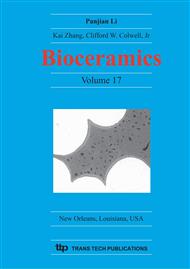p.745
p.749
p.753
p.757
p.761
p.765
p.769
p.775
p.779
Starch-Bioactive Glass Composite Microparticles: Bioactivity and Cellular Activity
Abstract:
In the present work we describe the synthesis of starch-based/BG 45S5 particles and their in vitro bioactivity behaviour by means of immersion in a simulated body fluid. The composite particles have shown to form a layer of Ca-P at their surface, whose nature was confirmed by chemical and morphological analysis. In order to evaluate the ability of these particles to be used as carriers for cell culture, undifferentiated rat cells were selected and parameters like cell adhesion, proliferation and expression of osteoblastic markers, were evaluated. The starch-based micro-particles have shown to support cellular activity, allowing cells to attach, proliferate and express specific markers while cultured in the particles surface. The final goal is to be able to use these particles as carriers for cells and simultaneously as in-situ forming constructs for tissue engineering and regenerative medicine applications.
Info:
Periodical:
Pages:
761-764
Citation:
Online since:
April 2005
Authors:
Keywords:
Price:
Сopyright:
© 2005 Trans Tech Publications Ltd. All Rights Reserved
Share:
Citation:


